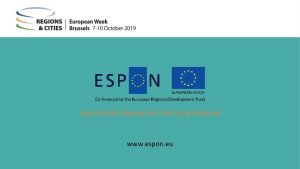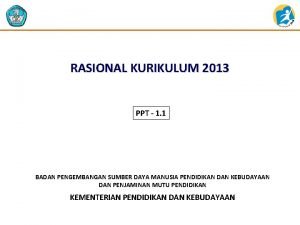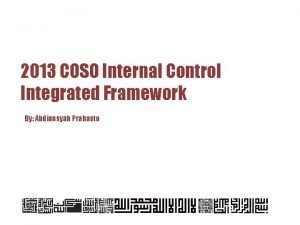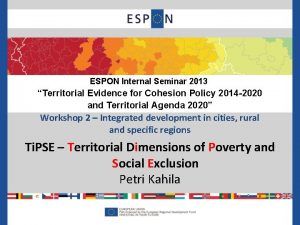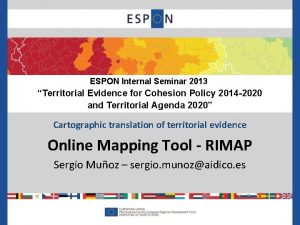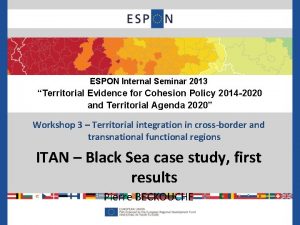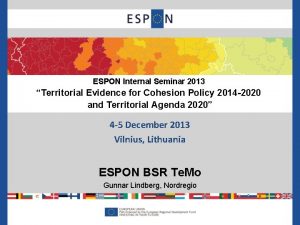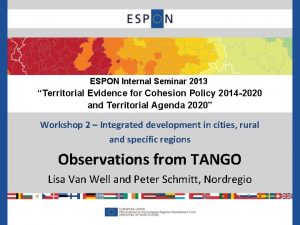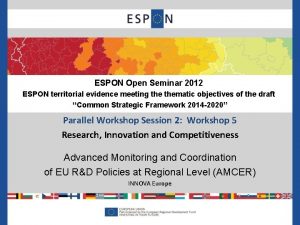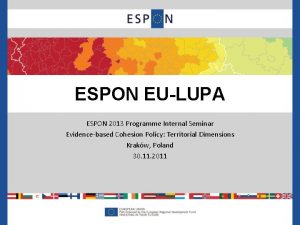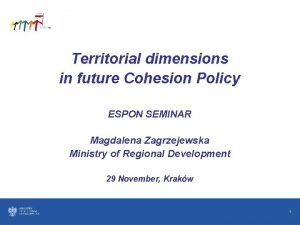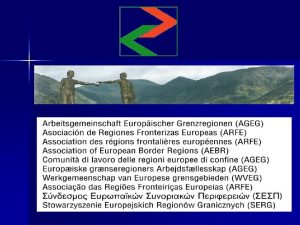ESPON Internal Seminar 2013 Territorial Evidence for Cohesion












- Slides: 12

ESPON Internal Seminar 2013 “Territorial Evidence for Cohesion Policy 2014 -2020 and Territorial Agenda 2020” Workshop 4 – Global competitiveness of regions based on strong local economies GREECO project Carlos Tapia (Tecnalia)

What is really about and why the green economy is a genuine win-win alternative? • As the operationalization of sustainable development The green economy “should contribute to eradicating poverty as well as sustained economic growth, enhancing social inclusion, improving human welfare and creating opportunities for employment and decent work for all, while maintaining the healthy functioning of the Earth’s ecosystems” (The future we want. Final document of the Rio+20 conference. United Nations, 2012, p. 9). … but at the same time strengthening territorial cohesion … From the purely economic perspective, the green economy is about increasing productivity and maximizing economic returns through: • Increased resource efficiency and reduced social-environmental direct and indirect costs of economic activities (EEA 2012; OECD 2011) more dynamic economies with less impacts. • Increasing added value of present products and services (e. g. through eco-design). • Generating new green products and services economic activities of a growing economic sector, expected to bring an Implicit environmental benefit (Eurostat 2009) 2

How can regional potentials for a greener economy be identified (1): Overall methodological approach 3

How can regional potentials for a greener economy be identified (2): Assessing regional green economic performance The map was built basing on a twofold approach : Bottom-up: For each of the sectors under study in GREECO, one key indicator has been selected. Top-down: For each green economy spheres (Environmental, Social, Territorial, Economic, and Econosphere) quantitative profiles of green economic performance are provided. Each sphere is represented by at least one indicator 6

How can regional potentials for a greener economy be identified (3): Defining regional potentials GREECO interpretation of territorial potentials (for a greener economy) “A combination of territorial factors (including external and internal forces) that generate a theoretical and mutable opportunity for future growth, improvement or expansion of the green economy in its diverse and concurrent manifestations (i. e. stronger economic growth, enhanced sustainability, increased social inclusion, and reinforced territorial cohesion)”. 8

How can regional potentials for a greener economy be identified (4): Scoping greening factors Greening factors proposed by GREECO project according to literature review, sectoral assessments and case studies. 9

How can regional potentials for a greener economy be identified (5): Assessing theoretical potentials for a greener economy 10

How can regional potentials for a greener economy be identified (6): Combining green economy performance (left) and potentials (right) 12

How can regional potentials for a greener economy be identified (7): Regional typology based on green economy performance and potentials 13

Main challenges and opportunities for a greener economy The regulatory framework is a key driver for green growth. The differences and potentials of territories should be reflected by policy-makers across Europe and across territorial levels in the implementation of policies contributing to green economy. A clear transformative political orientation and guidance through policy is needed, and the EU and its member states and regions could lead the way and set a positive example. Cities and regions are key actors in a green economy transition. Regions and local authorities have the potential and the necessary leverage to make a significant contribution to the achievement of the green economy through the definition of territorial actions under their competence. Cities and regions hold significant assets that are key building blocks in green economy development. The realisation of the potential of the territorial capital depends on a number of policy, institutional, political and financial factors. Local networks and local initiatives can support a transition of both the supply and demand side of the green economy by supplying information, education support to SME’s and concrete practical tools for engaging in greening initiatives. The lack of data at the regional and local levels is a real challenge. The lack of data is a major limitation creating comparable information for holding regions accountable to greening their economies. 14

Additional territorial evidence is needed in scoping… Key environmental relation and the way we consume key natural resources (e. g. for preserving biodiversity, re-use of waste, improving water quality, minimising environmental impact). Responsiveness to changes (e. g. how climate change adaptation and mitigation policies might intertwine with green economy policies to develop new green transport modes, sustainable waste and water management, induce changes in product design, etc. ). Energy relations (e. g. , how to further improve energy efficiency, renewable energy use, promote innovative technologies the energy sector, etc. ). Management and planning (e. g. certification, land use planning to favour circular economies, community involvement, demand management, etc. ). ‘Green footprint’ or visible impacts and outcomes of changes (e. g. assessing the territorial implications of the organic agriculture, carbon sequestration and other technologies, improved productivity, etc. ). User behaviour (e. g. the territorial dimension and economic implications of food habits and waste, use of wood as construction material, improved health security at a 15 workplace).

THANK YOU FOR YOUR ATTENTION 19
 Www.espon
Www.espon Rasional pengembangan kurikulum 2013
Rasional pengembangan kurikulum 2013 Coso 2013 cube
Coso 2013 cube Internal control images
Internal control images Fiber evidence can have probative value.
Fiber evidence can have probative value. Ecologic fallacy
Ecologic fallacy Secondary sources
Secondary sources Class evidence vs individual evidence
Class evidence vs individual evidence Primary evidence vs secondary evidence
Primary evidence vs secondary evidence Why does individual evidence have high probative value
Why does individual evidence have high probative value What is a primary source
What is a primary source Primary evidence vs secondary evidence
Primary evidence vs secondary evidence Individual vs class evidence
Individual vs class evidence
